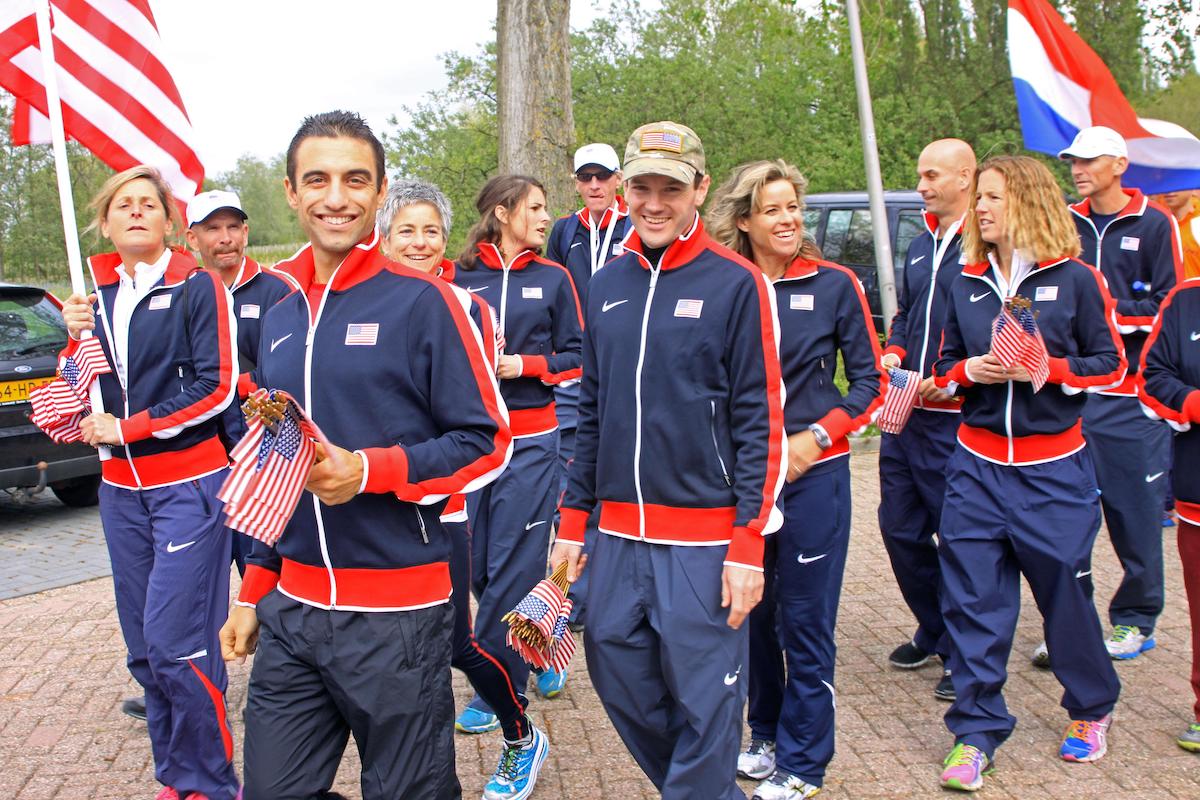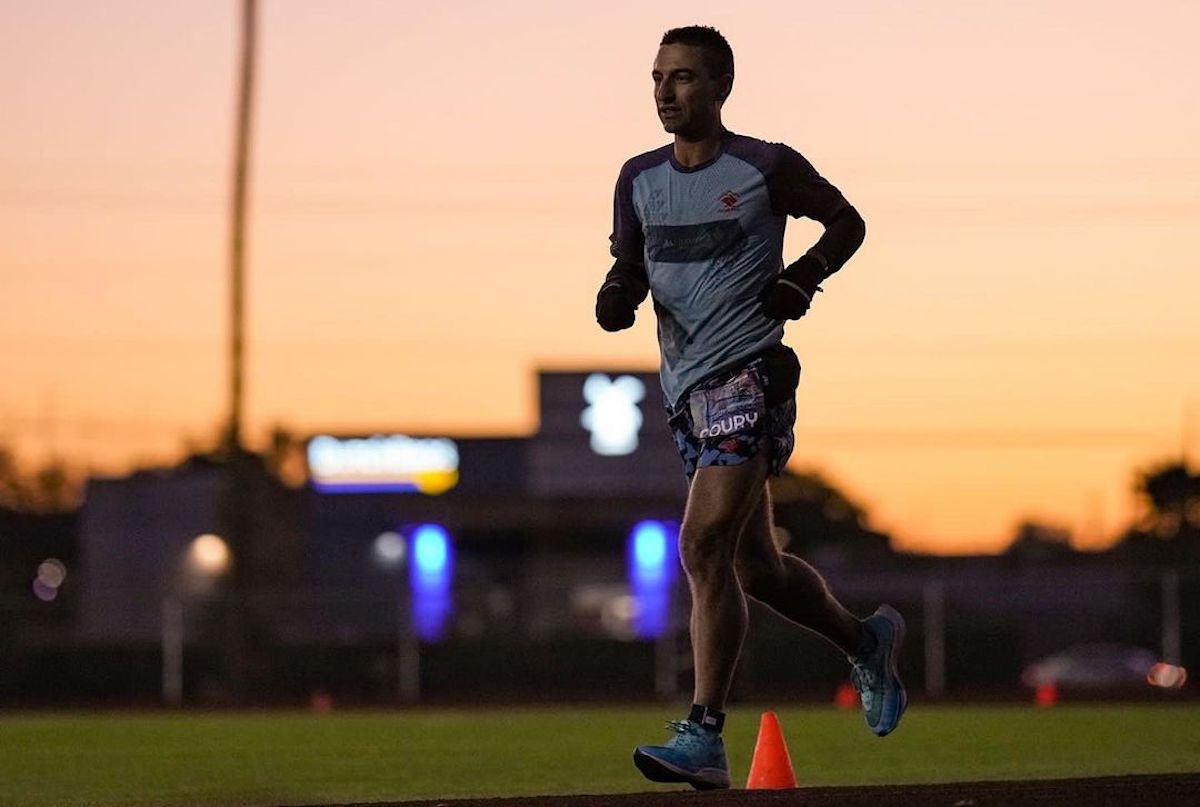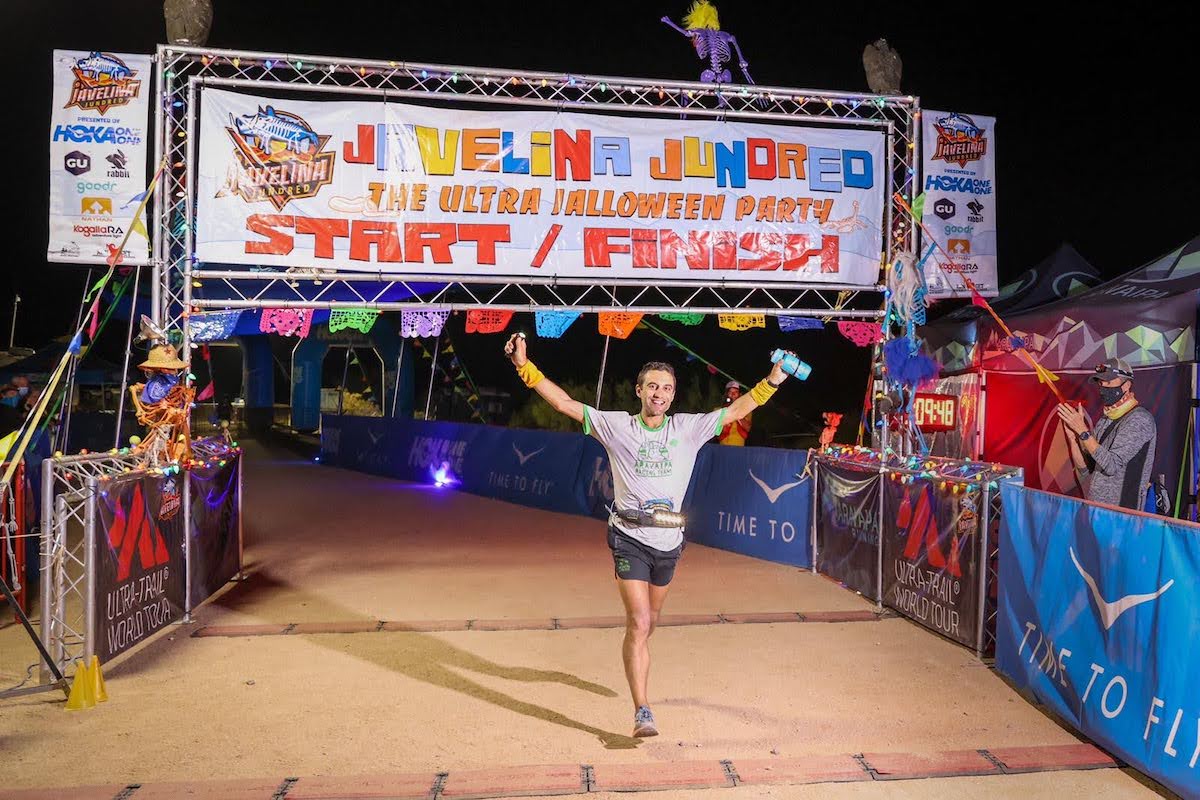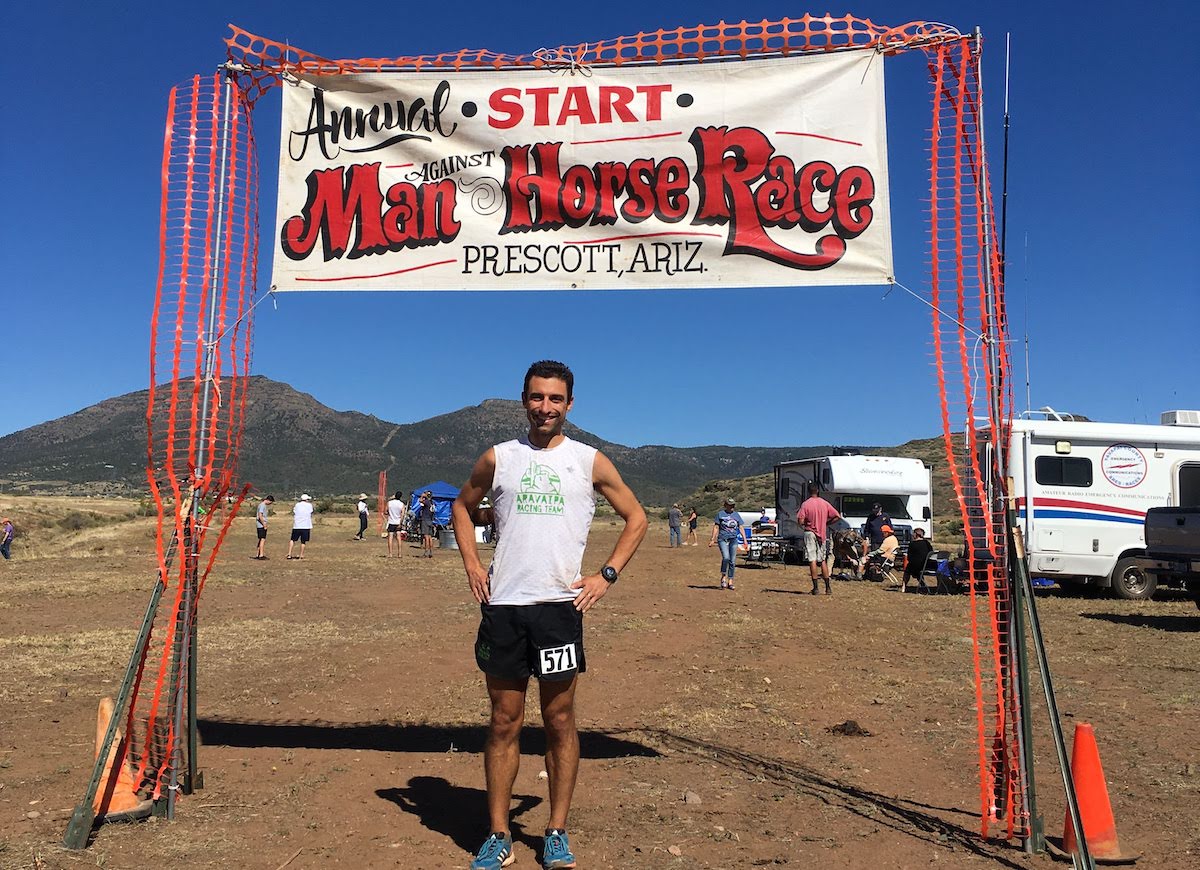Nick Coury has a heck of a racing resume. Since running his first ultramarathon in 2005, he has amassed over 30 first-place finishes, and he has raced competitively in some of the highest-profile races in the country like the Hardrock 100, Run Rabbit Run 100 Mile, Six Days in the Dome, and the Desert Solstice Track Invitational.
It seems Coury’s racing is aging like a fine wine: the years of hard work, precise planning, and race strategy all came together on Sunday, December 12, when Coury set a new men’s 24-hour American record, running 173.01 miles in 24 hours at Desert Solstice. In this effort, he bested the previous men’s 24-hour American record, set by Mike Morton at 172.45 miles in 2012, by just over a half-mile.
In this interview, Coury talks about how he attributes his massive improvement over the years — including his new 24-hour American record — to his nutrition strategy, his scientific approach to pacing including his consistent ability to negative split, and more.
[Editor’s Note: This interview has been edited and condensed for brevity and clarity.]
On Discovering Ultrarunning
I started running in high school because Jamil [Coury] did, and at the time I wanted to do everything my big brother did. I got into high-school cross country and then track, running the 800 meter, mile, and two mile.
Jamil got into the road racing scene, and did a road marathon. Then [we] got into the little niche trail running community as a result. It was tiny, and you had to talk to the right person to find out the one group trail run in this dark corner at 5:15 a.m. on Wednesday mornings, called the Wednesday Morning Running Club.

Nick (left), his brother Jamil (second from left), and other friends during their first ultra in 2005. Photo courtesy of Nick Coury.
Through that, [we] started finding out about the local races … one of them was a 12-hour night run [at the 2005 Kachina Relief 12 Hour Night Run]. That was our first ultra. We had no idea what we were doing. We thought, Running is fun, we like running. All night, it was like a sleepover type of thing. We can just stay out all night. We didn’t really know what we were doing.
We went out there and sprinted laps and then got tired, and so we jogged and sprinted some more, and then we sat around and ate potato chips and pretzels and drank Gatorade because that’s what was at the table.
It was totally bizarre and we were hooked and we all ran about 50 miles in 12 hours. My longest run before that, I think, was 13 miles, and then we did 50, without really knowing that it was an ultra.
That was 2005, and from there we discovered the trail long-distance stuff, which we seemed to have a knack for. I had a lot of up-and-down years earlier on as I figured things out, but I always wanted to be competitive. The 24-hour race was our second race, the Across the Years 24-Hour Race.
We were like, “If we can run 12 hours and do 50 miles, then we can do 100 miles in 24 hours, and you get this cool-looking buckle.” We went for it, and we all crashed and burned. I made the biggest improvement over 12 hours, and I did 20 extra miles in the extra 12 hours.
We had no clue what we were doing. We came back the next year, and Jamil and I got the 100 miles in 24 hours. That’s where my obsession with the 24-hour races started.
His First Years as an Ultrarunner
I learned about the U.S. 24-hour team, that you could qualify for and run at the IAU 24-Hour World Championships. At the time I was super cocky, like, “I only have to run 140 miles; I can do that.” I tried in 2008 and dropped out at about 50 miles.
I came back in 2010, when I put in my first real high-mileage blocks, started doing 100-mile weeks, and barely qualified. There used to be three automatic spots at the national championships, and I just barely got the minimum amount [of miles] to make the team.
Then the world championships got canceled. I tried to qualify again in 2012 and qualified for the team, so I got to go to the world championships in 2013.
There’s a small niche that gravitates toward [24-hour races] and it’s almost like a sub-community in ultrarunning. I fell into that, but I’m one of the few who crosses over [to other kinds of ultras] a lot. I clearly like the 24-hour race, but I love the trail more.
After the 2013 IAU 24-Hour World Championships, I took a five-year hiatus from 24-hour races. They are just brutal and relentless because of how flat they are; it’s just so hard to run that consistently for that long. I was doing trails at that time as well.
I did Hardrock for the first time in 2008 and focused on Hardrock after 2013 for quite a few years; got my fifth finish in 2017. Then finally I said, “Okay I will give the 24-hour race another shot.”

Nick with the rest of the U.S. 24-hour team at the 2013 IAU 24-Hour World Championships. Photo courtesy of Nick Coury.
With mountain races, it’s easy to explain their appeal to a non-runner. You get to the top of the peak and you look around and there are 100 snowcapped mountains everywhere. Even though it’s hard, it’s also incredibly inspiring. Versus, run on a 400-meter high-school track for 24 hours straight; it’s a much harder sell.
But what I like about it is, you want to know what you are capable of, and you want to pick a course that is going to support that and give you every opportunity to figure out your limits.
People bring up the question, “In ultras and 100 miles, does the person who ran 100 miles 13 hours, did they really have an easier day than someone who is out there for 29 hours for 100 miles?”
The 24-hour race is kind of a great equalizer. If you run faster, you have to go further. No matter how fast you run, no matter how good you are, you have to go all through the day and all through the night and back into the second day. You can’t outrun that. You have to face every single thing that every other person did, no matter how good you are.
The fact that you can control everything, you can take every other excuse out of the book. Sometimes you get hit with bad weather or the course was sabotaged and you got lost. All those [elements] get taken out and you lose every excuse.
At the end of the day, you can compare your performance against every other human who has ever attempted a 24-hour race. Within a very small margin of error, you have the [ability] to control every single aspect of it.
Negative Splitting in Ultras
[Being able to negative split] has been a work in progress for over a decade. The first time I started talking about this was in 2008, around Hardrock. I accidentally stumbled into [negative splitting], because I went out there not knowing what Hardrock was.
I qualified because Jamil wanted to run a qualifier, so I ran the Angeles Crest [100 Mile] with him, and then we qualified for some race called Hardrock. [I went] up there [to where it takes place] two weeks before, and I saw it and I’m like, “I might die out there.” The way all the veterans talked about all the bad things that happened during that race, I was pretty terrified.
I went so easy the entire race. With only 20 miles to go, I [knew] I had something left. I started going faster and faster. That was the year Kyle Skaggs broke 24 hours and blew away the course record. I beat his splits for the last 20 miles by a good bit.
[I did that] having no clue what I was doing — I was running 30 miles a week, mostly on flat canals. I had so much left at the end. I started thinking, Why don’t people finish this fast at the end of ultras?
At marathons and below that, that’s accepted. But no one talks about it in ultras. I spent a bunch of years thinking about that in my strategy. The second half of the race, [I would] pick people off and move up — just do really smart pacing.
The more I looked back at my actual splits, in my head, I thought I was crushing the second half. Then I looked at the actual paces, and they were not that good. I thought I was running super fast for 40 miles. But there might have been 10 miles in there that were pretty good.
In 2017 when I did Hardrock [again], I want to figure out how to not slow down late in the race. I wanted my fastest, best, strongest miles — not by how I feel, but what the numbers actually say, to be 80% of the way into the race. I was more fit going into that Hardrock than ever.
I started out slower than any other year. It felt ridiculous how slow I was going, I was just goofing off, loafing around. It felt like, I shouldn’t even be out there, I don’t deserve to be in this, I’m not even taking this seriously.
But then, sure enough, by the time we hit 80 miles, I felt better than ever. I ran by far my best time. Right at the very end, the last couple of miles, I was running about a six-minute-mile pace on the flats into town.
After that, I got real scientific and started developing a theory, a strategy, and models in my head. How do I make this better? How do I get it down to a science? One of the interesting things for me in ultras is, you look at marathons, and it is down to a science there.
They really have [training] distilled down and removed most variation. Ultras are very much the opposite. There’s just no repeatability or scientific thought to it. Everyone thinks of what works for them and they do it.
To me, the next evolution of ultras, in the way that we are going to blow people’s minds on what’s possible by human beings, is refining them more and finding the things that really make [achievements] repeatable. To push to the edge and take out a lot of those variables that make it so that everyone blows up all the time, you just don’t know when or how much. That’s what I’ve been doing for the last five years.
Learning How to Pace
In 2018, I hit my next big milestone when I negative split a 24-hour race and ran 155 miles, which was a 60-mile record for me. At that the time, I was at the absolute edge of my abilities. I paced well, and then in the last hour, got into this race with Greg Armstrong, who was in front of me, with both of us trying to make the U.S. 24-hour team.
I didn’t catch him because he put in a Herculean effort as well. But I pushed and got an extra mile just in the last hour, which pushed me over what I thought was possible.
I kept working at it from there. I thought about, What are the things that are going to keep getting me to push harder? I looked at my training and kept refining that. I played with diet; I played with nutrition; I played with all kinds of other factors, and incrementally got better and better.
In 2020 when I ran Desert Solstice, I was on pace for 167 [miles] and started to negative split, started to speed up the second half. Then at 19 hours in, just five hours to go, I fell off the face of the earth. My quads blew up, the muscles weren’t firing, they just refused to work anymore.
I slowed in the course of an hour from probably 8:30 pace to 10-minute pace, 11-minute pace, or slower. I sprinted at the very end but it hurt really bad. Still, I ended up with 155 [miles] again.
After that, all I could think was, I was on pace for running 167 [miles in 24 hours], but the last five hours — and I know better than almost anyone — are the most critical. It’s easy to say, “Oh, if I could just hold on for five hours,” but those five hours are the only important hours.
In my head, I’m like, What if I fix the quads? Is that the only bottleneck? What are the other bottlenecks, can I fix those? Maybe I can figure this all out in a year and then get to 167 [miles]. I started asking, Well, 167, that’s a huge jump from 155 two years before. Maybe I can work harder, get more fitness, figure out some other details.
You start pushing that up, maybe 168, 169, 170 … There’s this mark at 172.5, only a little bit further than that even; that’s this American record that I can’t even imagine going after. If I squint and then squint some more, it’s not the farthest thing that ever possibly could exist.
The Experience at the 2021 Desert Solstice
I was thinking, I need to save every single second because I will need them out there. Even down to the sprint at the end, I felt like I could have done that earlier, but all I could think the last several hours is, I’m going to pick it up with 20 minutes to go, and some muscle is going to pull, and I’m going to collapse and that’s going to be it.
Until I cross that line, I cannot get excited, get cocky, put in anything more than the minimum to make sure I get there. And then once I crossed it, I just gave everything else I had.
I was pretty solid [mentally] the whole time and that’s one of the biggest improvements I made from last year. [Last year] I went into a real dark place when everything went south. I was refusing help, I was refusing to problem-solve or think through anything, and that’s just when I was like, “I’m done, I’m just going to sit in this chair right here and wait out my win.” Super stubbornly.
That’s one of the things I had to figure out how to get past. I did a 24-hour race in May, that was one of the big goals there. I ran high mileage straight into the race. My coach James [Bonnett] kind of made me, because I think he wanted to make me go through some of that to figure it out.
A bunch of the sport-psychology stuff I was working on popped up right when I needed it, and I was able to figure out, I figured out how to just click out of a dark place. I used that throughout this race. I never really hit a low point.

Nick on his way to winning the 2021 Desert Solstice and setting a men’s 24-hour American record. Photo: Howie Stern
My nutrition was mostly planned but it’s not strict. My biggest source of calories — which I’m going to change because this was the biggest problem I had in the race — was fruit smoothies. I’ve had issues in the past with traditional sports stuff, because I get really sick of all the sugar and then don’t want to eat anything. I can’t do gels or sports drinks or stuff like that.
The fruit smoothies are a perfect balance: they burn really quick and it’s really clean, solid energy. It gives my gut a little something to hang onto and they are tasty. I had them in little eight-ounce bottles. I mixed some extra maltodextrin in there just to boost the calorie count. I put a little extra stuff in there like some protein powder. BCAAs, and stuff like that, other stuff I knew that I would want to periodically take.
I did a couple of other things, like pita-hummus-avocado wraps, gummy worms, and some granola bars. I had a rough calorie target per hour, but I could [mostly] go by the feel of my gut. I take Vespa, and then I am also on the higher fat metabolism diet program. The focus on keeping my fat metabolism high has helped a lot, especially in these real long races. Between all that, I didn’t have any energy issues the whole day.
But the issue I mentioned with the fruit smoothies; they started causing some gas issues about halfway into the race that lasted the rest of the time. I had many more bathroom breaks than I wanted. I’ve been thinking, it probably added up to about three or four minutes, so that’s something I will be rethinking the next time.
About How It Feels to Set the Men’s 24-Hour American Record
I still don’t even know how to feel about [the record]. It doesn’t feel real, it’s nothing that I ever assumed I would be capable of. I’ve been doing this for 16 years now. Usually, if you have been in it that long and trying hard for that long, you have kind of tapered off on how much you can get better. I was far from anything like this, there are so many people way better than me, it didn’t even cross my mind.
Even a year ago when I started thinking about it, it felt kind of fake, like I’m lying to myself, that this isn’t even something I should consider. Luckily, that didn’t get in the way of me still wanting to see if it’s possible.
I think that’s going back to the appeal of the 24-hour race is, even if I can’t get there, the process of imagining it is probably going to push me farther than I ever thought possible. I kind of just want to see where I can end up and it turned out where that is, is half a mile past the previous American record.



